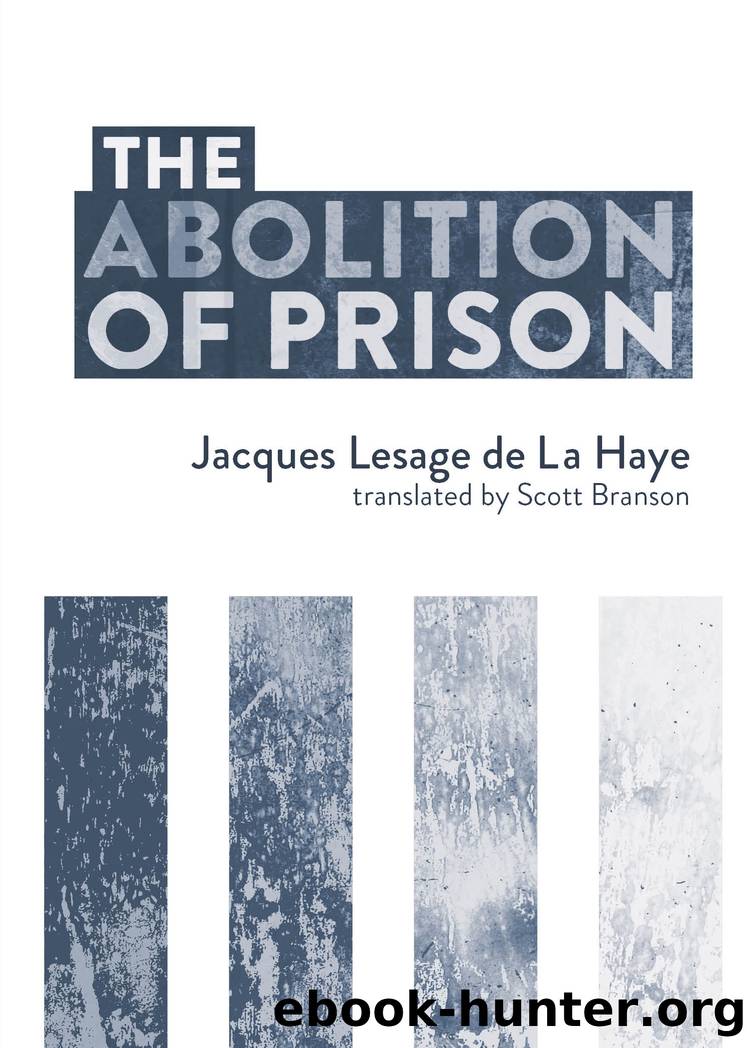The Abolition of Prison by Lesage de La Haye Jacques;Branson Scott;

Author:Lesage de La Haye, Jacques;Branson, Scott;
Language: eng
Format: epub
Publisher: AK Press
Published: 2021-05-16T00:00:00+00:00
* * *
1. Jacquard, Un Monde sans prisons, 211.
2. Briggs, In Place of Prisons, 108.
3. Ibid.
4. Ibid., 59.
5. Ibid., 124.
6. Ibid., 10.
Chapter Seven: Recent and Current Alternatives to Incarceration
In the 1980s, a daring lawyer, named Duccio Scatolero, took up the baton. Seriously concerned about the young people incarcerated in the juvenile wing in the Turin prison, he figured out a solution that would make an effective intervention. We met in 1985 in Ãvry. He believed that one of the best ways to make change was to mobilize the people. He presented a film that had a very clear message. In it, we saw townspeople interviewed about delinquents. Their remarks were distressing, but commonplace: âThey are deadbeats. We have to put them in prison. We canât let such dangerous people be free.â
Scatolero then had the interviewees visit prison and spoke to them afterwards. Their position was completely transformed: âItâs dreadful! That could be our children. They are kept inactive. Thatâs not how theyâll be let back out. Prison is not the answer.â The lawyer took the opportunity to ask them, âBut what else could we do?â The answer came quickly: âWe need training workshops so that they learn trades.â The following months were devoted to the development of various trainings inside prison: cooking, baking, butchery, mechanics . . . The organization responsible for the trainings had around two thousand members. Many were craftspeople, merchants, and residents from the town. They were highly active and determined to work together to transform the condition of these young incarcerated people.
In the prison at this time, sentences remained rather short. Like in France, the average wasnât more than five months. The trainees were almost all released at the end of their sentence before theyâd finished their training. Two options arose: either the craftspeople hired the youth in their own businesses and, thus, they could complete their trainings; or they would end up back insideâwhich had been the common resultâand so those who re-offended could resume their training where they left off and thereby bring it to a successful completion.
The resolution was funny, to say the least. At the end of five years, Scatolero met with the director of the juvenile wing, which had at first incarcerated a hundred people. Now, only eight remained. The director exclaimed to the lawyer: âMr. Scatolero, youâve stolen my prison!â
At the end of the 1980s, a team of teachers from Child and Youth Services established a farm, Laplanche, in a small village, Champoly, between Puy-en-Velay and Saint-Ãtienne. Juveniles went there instead of going to prison. At first, they renovated the premises as a group, then started growing crops and then raising farm animals. The youth came voluntarily to Champoly. They agreed to undertake agricultural work. By and large, they had been sentenced from six months to two years.
But the activities didnât stop with farm work. The teachers invited groups and organizations from Saint-Ãtienne to come meet with the residents. They organized cultural trips to the town. The idea behind
Download
This site does not store any files on its server. We only index and link to content provided by other sites. Please contact the content providers to delete copyright contents if any and email us, we'll remove relevant links or contents immediately.
Nudge - Improving Decisions about Health, Wealth, and Happiness by Thaler Sunstein(7241)
iGen by Jean M. Twenge(5161)
The Fire Next Time by James Baldwin(5016)
Adulting by Kelly Williams Brown(4231)
The Hacking of the American Mind by Robert H. Lustig(4082)
The Sports Rules Book by Human Kinetics(4077)
The Ethical Slut by Janet W. Hardy(4036)
Captivate by Vanessa Van Edwards(3722)
Mummy Knew by Lisa James(3520)
In a Sunburned Country by Bill Bryson(3364)
The Worm at the Core by Sheldon Solomon(3325)
Ants Among Elephants by Sujatha Gidla(3279)
Suicide: A Study in Sociology by Emile Durkheim(2903)
The Slow Fix: Solve Problems, Work Smarter, and Live Better In a World Addicted to Speed by Carl Honore(2837)
The 48 laws of power by Robert Greene & Joost Elffers(2801)
Humans of New York by Brandon Stanton(2686)
Handbook of Forensic Sociology and Psychology by Stephen J. Morewitz & Mark L. Goldstein(2603)
The Happy Hooker by Xaviera Hollander(2582)
The Tipping Point by Malcolm Gladwell(2554)
